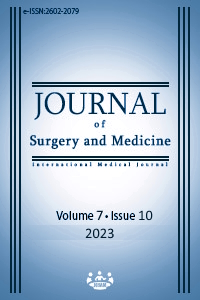Evaluation of risk factors for anal human papillomavirus infection in heterosexual women diagnosed with human papillomavirus associated cervical dysplasia
Risk factors for anal human papillomavirus infection
Keywords:
anal cancer, cervical intraepithelial neoplasia, human papillomavirus, screeningAbstract
Background/Aim: Cervical dysplasia is a well-recognized precursor to cervical cancer, and human papillomavirus (HPV) infection is the primary causative agent in its development. The intricate relationship between cervical and anal HPV infections remains understudied. There have been no established risk factors determined for anal HPV infection in women without a history of anal intercourse. This study aims to address this critical knowledge gap by evaluating the risk factors for anal HPV infection in a homogeneous population of heterosexual women with HPV-associated cervical dysplasia.
Methods: This retrospective cohort study was carried out in a single tertiary center and comprised women between the ages of 30 and 65. Women diagnosed with either low-grade squamous intraepithelial lesion (LSIL) or high-grade squamous intraepithelial lesion (HSIL) and without a history of anal intercourse were included in the analysis. Participants without a histological or colposcopic diagnosis were excluded from the analysis. Women with a history of prior cervical therapeutic intervention, previous cervical or genital dysplasia, known immunosuppressive disorders, current immunosuppressive medication use, a past cancer diagnosis, or a history of HPV vaccination were also excluded. Anal sampling was performed for HPV infection within the first year after the initial diagnosis of cervical dysplasia. Patient characteristics including smoking status were extracted from patient files.
Results: Overall, 186 women who met the inclusion criteria were tested for active anal HPV infection of the anal canal. Active anal HPV infection was found in 96 (51.6%) of the patients. In women with active anal HPV infection, 31 (32.3%) were found to have only HPV 16/18 genotypes, and 22 had HPV16/18 along with other high-risk types. When risk factors were analyzed, only current smoking was found to be associated with anal HPV infection in this group of women. Overall, 40.6% of the women with active anal HPV infection were smokers; however, only 25.6% of the women without anal HPV infection were current smokers (P=0.029).
Conclusion: Women had a high risk of active anal HPV infection during the diagnosis of cervical intraepithelial neoplasia. Current smoking was the only identifiable risk factor for anal HPV infection in women without anal intercourse history.
Downloads
References
Braaten KP, Laufer MR. Human Papillomavirus (HPV), HPV-Related Disease, and the HPV Vaccine. Rev Obstet Gynecol. 2008;1(1):2-10.
Ozgen U, Guler T, Kilic D, Gokakin A, Aykota M, Kaleli I, et al. Is the Anal Component of the Anogenital HPV-Related Disease Overlooked During the Surveillance of Patients Treated for Cervical Intraepithelial Neoplasia? Cureus. 2023;15(9):e44731. DOI: https://doi.org/10.7759/cureus.44731
Schiffman M, Castle PE, Jeronimo J, Rodriguez AC, Wacholder S. Human papillomavirus and cervical cancer. Lancet. 2007;370(9590):890-907. DOI: https://doi.org/10.1016/S0140-6736(07)61416-0
Beka H. A retrospective cohort study of human papillomavirus (HPV) genotypes in women with abnormal Pap smear cytology in Turkey. J Surg Med. 2023;7(9):637-40. DOI: https://doi.org/10.28982/josam.7910
Lammé J, Pattaratornkosohn T, Mercado-Abadie J, Alkhas A, Robinson A, Lanneau G. Concurrent anal human papillomavirus and abnormal anal cytology in women with known cervical dysplasia. Obstet Gynecol. 2014;124:242-8. DOI: https://doi.org/10.1097/AOG.0000000000000370
D'Hauwers KW, Cornelissen T, Depuydt CE, Bogers J, Donders AR, Leuridan E, et al. Anal human papillomavirus DNA in women at a colposcopy clinic. Eur J Obstet Gynecol Reprod Biol. 2012;164(1):69-73. DOI: https://doi.org/10.1016/j.ejogrb.2012.05.014
Guler T, Uygur D, Uncu M, Yayci E, Atacag T, Bas K, et al. Coexisting anal human papilloma virus infection in heterosexual women with cervical HPV infection. Arch Gynecol Obstet. 2013;288(3):667-72. DOI: https://doi.org/10.1007/s00404-013-2821-0
Crosbie EJ, Einstein MH, Franceschi S, Kitchener HC. Human papillomavirus and cervical cancer. Lancet. 2013;382(9895):889-99. DOI: https://doi.org/10.1016/S0140-6736(13)60022-7
Valari O, Koliopoulos G, Karakitsos P, Valasoulis G, Founta C, Godevenos D, et al. Human papillomavirus DNA and mRNA positivity of the anal canal in women with lower genital tract HPV lesions: predictors and clinical implications. Gynecol Oncol.2011;122(3):505–8. DOI: https://doi.org/10.1016/j.ygyno.2011.05.033
McGovern J, Fuller C, Burris K. Anal cancer screening and prevention: a review for dermatologists. J Eur Acad Dermatol Venereol. 2021;35(8):1622-7. DOI: https://doi.org/10.1111/jdv.17263
Clarke MA, Deshmukh AA, Suk R, Roberts J, Gilson R, Jay N, et al. A systematic review and meta-analysis of cytology and HPV-related biomarkers for anal cancer screening among different risk groups. Int J Cancer. 2022;151(11):1889-901. DOI: https://doi.org/10.1002/ijc.34199
Umutoni V, Schabath MB, Nyitray AG, Wilkin TJ, Villa LL, Lazcano-Ponce E, et al. The Association between Smoking and Anal Human Papillomavirus in the HPV Infection in Men Study. Cancer Epidemiol Biomarkers Prev. 2022;31(8):1546-53. DOI: https://doi.org/10.1158/1055-9965.EPI-21-1373
Keller K, Ramos-Cartagena JM, Guiot HM, Muñoz C, Rodríguez Y, Colón-López V, et al. Association of smoking with anal high-risk HPV infection and histologically confirmed anal high-grade squamous intraepithelial lesions among a clinic-based population in Puerto Rico. Cancer Treat Res Commun. 2022;30:100503. DOI: https://doi.org/10.1016/j.ctarc.2021.100503
Shvetsov YB, Hernandez BY, McDuffie K, Wilkens LR, Zhu X, Ning L, et al. Duration and clearance of anal human papillomavirus (HPV) infection among women: the Hawaii HPV cohort study. Clin Infect Dis. 2009;48(5):536-46. DOI: https://doi.org/10.1086/596758
Downloads
- 363 675
Published
Issue
Section
How to Cite
License
Copyright (c) 2023 Utku Özgen
This work is licensed under a Creative Commons Attribution-NonCommercial-NoDerivatives 4.0 International License.
















